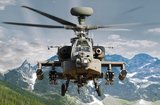Danish flying doctors in Afghanistan
Chief of Staff of Tactical Air Command recently visited the Danish-led field hospital at Camp Bastion, where three of the Danish doctors have a very specific job on board the big Chinook helicopters.
Among the Danish personnel at the Field Hospital at Camp Bastion are three doctors who are specially trained to retrieve wounded soldiers in the field. The evacuation of the wounded soldiers happens by British Chinook helicopters, which will soon be replaced by the Merlin EH-101 by the Danish Air Force.
It was therefore natural that the chief of staff of Tactical Air Command, Brigadier General Max Everything Nielsen, got a thorough briefing on the three functions of doctors in the Medical Emergency Rescue Team, MERT, since brigadier generals recently visited the Field Hospital.
The three-MERT doctors at the Field Hospital are the only Danes who have undergone the necessary training making them eligible to work in a British medical MERT team.
"We usually land in the middle of the battlefield. The helicopters are a favorite target among Taliban fighters, it may turn out that we return with some bullet holes in the helicopter. Fortunately Chinooks are well armoured, but it is a risky job to be MERT-doctor, and it is almost a requirement that you must have been in a firefight. Or at least have been on patrol and be aware of what it means to be in a firefight before you can become a part of the MERT team, tells anesthetist Peter A. Christensen, nicknamed PAC.
The Danish MERT doctors spend three months with the Field Hospital alternately taking turns with two British-MERT teams. Each MERT team consists of a doctor, a paramedic, a medical orderly and a nurse who is on a 24 hour shift at a time. The two MERT teams covering the whole province of Helmand, but when the alarm sounds, it takes on average only 22 minutes before the team is treating a wounded soldier.
"We have approximately 22 minutes to treat the patient while we are in the air. It makes great demands on MERT-physician's skill, age and experience. Among other things you could be working in the dark on the tailgate of a Chinook helicopter, one should be able to unlock the airways in the dark and could open the chest to the patient to put the clamps on his main artery. So it requires doctors who are either in the course staff or specialists who have a thorough knowledge of anesthesia," says PAC.
"You must be used to treat acute patients, you must be medical SAR (Search and Rescue, ed.) And have a course in C-SAR (Combat Search and Rescue). A course of treatment of wounded on the battlefield, and a course in emergency medicine is also a requirement. And you must have a thorough knowledge of weapons," says PAC.
"I think we are doing some thinking in the direction of Combat Support Wing in Karup. Specifically, how far the plans, I am not aware. But the last three months, my two-MERT colleagues and I gained a unique experience, and not least, we have created ourselves a network among the British MERTS people. And we were obviously happy to help the Air Force if we can help develop a Danish MERT team," says PAC.
(Translated from the Danish Air Force website)
More from Defence Helicopter
-
![Germany to send WS-61 Westland Sea King helicopters to Ukraine]()
Germany to send WS-61 Westland Sea King helicopters to Ukraine
Germany has committed to sending Ukraine six of its 21 retiring WS-61 Westland Sea King multirole, amphibious helicopters.
-
![Boeing secures $271 million to advance modernisation of US Special Operations' MH-47G Chinook]()
Boeing secures $271 million to advance modernisation of US Special Operations' MH-47G Chinook
Boeing has clinched a major contract modification to further its backing of the US Special Operations Command’s MH-47G Chinook aircraft modernisation effort.
-
![Dubai Airshow 2023: South Korean homegrown helicopters make international debut]()
Dubai Airshow 2023: South Korean homegrown helicopters make international debut
Two KAI helicopters, the KUH-1E utility helicopter and the Light Attack Helicopter (LAH), have taken centre stage at the Dubai Airshow 2023.
-
![Italian Navy receives final NH90 helicopter]()
Italian Navy receives final NH90 helicopter
The Italian Navy now boasts a fleet of 56 NH90 helicopters comprising 46 SH-90As and 10 MH-90As.
-
![Argentina seeks AW109 and CH-46 Sea Knight helicopters]()
Argentina seeks AW109 and CH-46 Sea Knight helicopters
The Argentinian Air Force (FAA) and the Argentinian Naval Aviation Command (COAN) are looking for options to upgrade their helicopter fleets.
-
![DSEI 2023: Lockheed to produce about 40% of Black Hawks on UK soil if it wins NMH contest]()
DSEI 2023: Lockheed to produce about 40% of Black Hawks on UK soil if it wins NMH contest
Lockheed Martin promises a boost to the British job market and export opportunities, while strengthening ties with Poland and positioning the UK for a future in rotorcraft technology in the event of a New Medium Helicopter competition triumph.



























